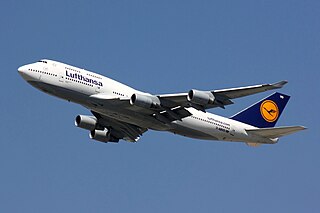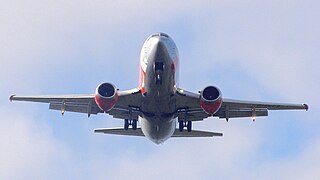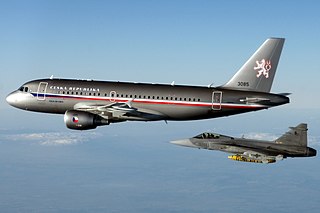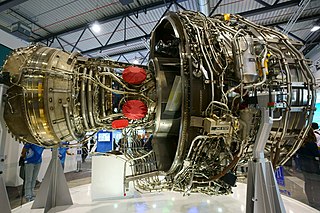Related Research Articles
Finnair is the flag carrier and largest full-service legacy airline of Finland, with headquarters in Vantaa on the grounds of Helsinki Airport, its hub. Finnair and its subsidiaries dominate both domestic and international air travel in Finland. Its major shareholder is the government of Finland, which owns 55.9% of its shares. Finnair is a member of the Oneworld airline alliance.

The Airbus A340 is a long-range, wide-body passenger airliner that was developed and produced by Airbus. In the mid-1970s, Airbus conceived several derivatives of the A300, its first airliner, and developed the A340 quadjet in parallel with the A330 twinjet. In June 1987, Airbus launched both designs with their first orders and the A340-300 took its maiden flight on 25 October 1991. It was certified along with the A340-200 on 22 December 1992 and both versions entered service in March 1993 with launch customers Lufthansa and Air France. The larger A340-500/600 were launched on 8 December 1997; the A340-600 flew for the first time on 23 April 2001 and entered service on 1 August 2002.

The Airbus A380 is a large wide-body airliner that was developed and produced by Airbus. It is the world's largest passenger airliner and only full-length double-deck jet airliner. Airbus studies started in 1988, and the project was announced in 1990 to challenge the dominance of the Boeing 747 in the long-haul market. The then-designated A3XX project was presented in 1994; Airbus launched the €9.5 billion ($10.7 billion) A380 programme on 19 December 2000. The first prototype was unveiled in Toulouse on 18 January 2005, with its first flight on 27 April 2005. It then obtained its type certificate from the European Aviation Safety Agency (EASA) and the US Federal Aviation Administration (FAA) on 12 December 2006.

A wide-body aircraft, also known as a twin-aisle aircraft, is an airliner with a fuselage wide enough to accommodate two passenger aisles with seven or more seats abreast. The typical fuselage diameter is 5 to 6 m. In the typical wide-body economy cabin, passengers are seated seven to ten abreast, allowing a total capacity of 200 to 850 passengers. The largest wide-body aircraft are over 6 m (20 ft) wide, and can accommodate up to eleven passengers abreast in high-density configurations.

Cruise is the phase of aircraft flight that starts when the aircraft levels off after a climb, until it begins to descend for landing. Cruising usually comprises the majority of a flight, and may include changes in heading, airspeed, and altitude.

The Boeing 747-400 is a large, long-range wide-body airliner produced by Boeing Commercial Airplanes, an advanced variant of the initial Boeing 747. The "Advanced Series 300" was announced at the September 1984 Farnborough Airshow, targeting a 10% cost reduction with more efficient engines and 1,000 nautical miles [nmi] of additional range. Northwest Airlines became the first customer with an order for 10 aircraft on October 22, 1985. The first 747-400 was rolled out on January 26, 1988, and made its maiden flight on April 29, 1988. Type certification was received on January 9, 1989, and it entered service with NWA on February 9, 1989.

The Airbus A350 is a long-range, wide-body twin-engine jet airliner developed and produced by Airbus. The first A350 design proposed by Airbus in 2004, in response to the Boeing 787 Dreamliner, would have been a development of the Airbus A330 with composite wings and new engines. As market support was inadequate, in 2006, Airbus switched to a clean-sheet "XWB" design, powered by two Rolls-Royce Trent XWB high bypass turbofan engines. The prototype first flew on 14 June 2013 from Toulouse, France. Type certification from the European Aviation Safety Agency (EASA) was obtained in September 2014, followed by certification from the Federal Aviation Administration (FAA) two months later.

Afriqiyah Airways is a Libyan airline based in Tripoli, Libya. It was established in 2001 and operates both domestic and international flights. The airline's main hub is Tripoli International Airport (TIP), and it serves a wide range of destinations across Africa, the Middle East, and Europe.

The Rolls-Royce Trent 900 is a high-bypass turbofan produced by Rolls-Royce plc to power the Airbus A380, competing with the Engine Alliance GP7000. Initially proposed for the Boeing 747-500/600X in July 1996, this first application was later abandoned but it was offered for the A3XX, launched as the A380 in December 2000. It first ran on 18 March 2003, made its maiden flight on 17 May 2004 on an A340 testbed, and was certified by the EASA on 29 October 2004. Producing up to 374 kN (84,000 lbf), the Trent 900 has the three shaft architecture of the Rolls-Royce Trent family with a 2.95 m (116 in) fan. It has a 8.5–8.7:1 bypass ratio and a 37–39:1 overall pressure ratio.

A twinjet or twin-engine jet is a jet aircraft powered by two engines. A twinjet is able to fly well enough to land with a single working engine, making it safer than a single-engine aircraft in the event of failure of an engine. Fuel efficiency of a twinjet is better than that of aircraft with more engines. These considerations have led to the widespread use of aircraft of all types with twin engines, including airliners, fixed-wing military aircraft, and others.

A hydrogen-powered aircraft is an aeroplane that uses hydrogen fuel as a power source. Hydrogen can either be burned in a jet engine or another kind of internal combustion engine, or can be used to power a fuel cell to generate electricity to power an electric propulsor. It cannot be stored in a traditional wet wing, and hydrogen tanks have to be housed in the fuselage or be supported by the wing.

Premium economy class, also known by brand names which vary by company, is a travel class offered on many airlines. It is usually positioned between standard economy class and business class in terms of price, comfort, and available amenities. In 1991, EVA Air was the first to introduce Evergreen Class, becoming the first airline to offer this class of service. It was widely acknowledged that the premium economy class has become a standard reflection of what the economy class was like several decades ago. In some countries, this class has emerged as a response from governments and companies requiring economy class for travel done by staff.

Airbus Corporate Jets, a business unit of Airbus SAS and part of Airbus, markets and completes corporate jet variants from the parent's airliner range. Types include the A318 Elite to the double/triple-decked Airbus A380 Prestige. Following the entry of the 737-based Boeing Business Jet, Airbus joined the business jet market with the A319 Corporate Jet in 1997. Although the term Airbus Corporate jet was initially used only for the A319CJ, it is now often used for all models, including the VIP widebodies. As of June 2019, 213 corporate and private jets are operating; 222 aircraft have been ordered, including 128 A320 family jets.

The Delta Air Lines fleet consists of 945 aircraft, making it the largest airline by fleet size in the world, ahead of American Airlines. Delta Air Lines operates a fleet manufactured by Airbus and Boeing, and is the largest operator of the Airbus A220, Boeing 717, Boeing 757, and Boeing 767, and has the largest Airbus A330 and Airbus A350 fleet of any US airline.

The fuel economy in aircraft is the measure of the transport energy efficiency of aircraft. Efficiency is increased with better aerodynamics and by reducing weight, and with improved engine brake-specific fuel consumption and propulsive efficiency or thrust-specific fuel consumption. Endurance and range can be maximized with the optimum airspeed, and economy is better at optimum altitudes, usually higher. An airline efficiency depends on its fleet fuel burn, seating density, air cargo and passenger load factor, while operational procedures like maintenance and routing can save fuel.

The Rolls-Royce Trent XWB is a high-bypass turbofan produced by Rolls-Royce Holdings. In July 2006, the Trent XWB was selected to power exclusively the Airbus A350. The first engine was run on 14 June 2010, it first flew on an A380 testbed on 18 February 2012, it was certified in early 2013, and it first flew on an A350 on 14 June 2013. It had its first in-flight shutdown on 11 September 2018 as the fleet accumulated 2.2 million flight hours. It keeps the characteristic three-shaft layout of the Rolls-Royce Trent, with a 3.00 m (118 in) fan, an IP and HP spool. The 84,200–97,000 lbf (375–431 kN) engine has a 9.6:1 Bypass ratio and a 50:1 Pressure ratio. It is the most powerful member of the Trent family.
Lufthansa operates a mainline fleet consisting of Airbus narrow and widebody and Boeing widebody aircraft. The mainline fleet is composed of eight different aircraft families: the Airbus A320ceo and A320neo families as well as the Airbus A330, Airbus A340, Airbus A350, Boeing 747 and Boeing 787 Dreamliner. Additionally, Lufthansa currently has orders placed for their A320neo family to replace their ageing A320-200 fleet. There are also orders for new Airbus A350s and Boeing 777Xs. The 777X will replace all Boeing 747-400s in the fleet. The 787s, together with the A350s, will replace all remaining Airbus A340 aircraft. The airline also announced the return of three previously retired A380 aircraft to start in 2023, servicing Boston, New York (JFK), Los Angeles, and Bangkok.

The Airbus A330neo is a wide-body airliner developed by Airbus from the Airbus A330. A new version with modern engines comparable with those developed for the Boeing 787 was called for by operators of the original A330 series. It was launched on 14 July 2014 at the Farnborough Airshow, promising 14% better fuel economy per seat. It is exclusively powered by the Rolls-Royce Trent 7000 which has double the bypass ratio of its predecessor.
Air France operates a fleet of 210 aircraft, mostly Airbus aircraft. Its narrow-body fleet consists of all-four Airbus A320 family variants, on the other hand the wide-body aircraft of Airbus A330, Airbus A350, Boeing 777 and Boeing 787 serve as long-haul operations. The airline has also ordered the short-to-medium-haul Airbus A220 to replace their aging Airbus A318s and Airbus A319s.In September 2023 Air France-KLM announced an additional order for 50 Airbus A350s to replace their Airbus A330 and their Boeing 777-200ER.
Dutch flag-carrier airline KLM operates a fleet of 110 aircraft. The narrow-body fleet is composed of Boeing 737 Next Generation aircraft which will be replaced by the Airbus A320neo family aircraft in the mid 2024. Airbus A330, Boeing 777 and Boeing 787 Dreamliner widebody aircraft are used primarily on long-haul flights. In September 2023 Air France-KLM announced an order for 50 Airbus A350s which will replace the Airbus A330 and the Boeing 777-200 and the order is to be split between Air France and KLM.
References
- 1 2 3 "Flying-V". TU Delft. Retrieved 2019-09-11.
- 1 2 Dixon, Emily (2019-06-03). "Flying-V will carry passengers in its wings". CNN Travel.
- ↑ "Flying-V prototype plane to take to skies in 2019". The West Australian. 2019-06-03.
- ↑ Justus Benad. "The Flying V".
- 1 2 "Flying-V Concept Secures KLM Backing". AIN online. 2019-06-17.
- ↑ Woodyatt, Amy (2020-09-05). "Futuristic 'Flying-V' airplane makes successful maiden flight". CNN. Retrieved 2020-09-06.